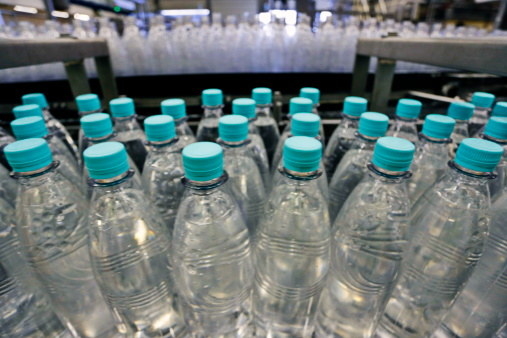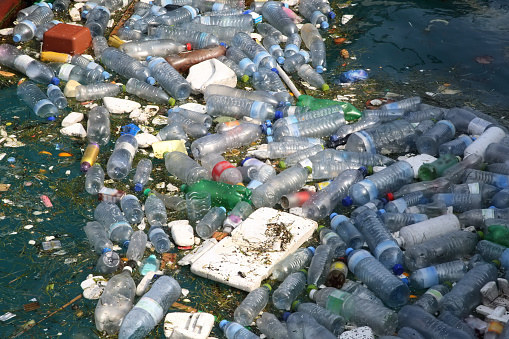 |
| Advertisement |
Bottled water is often marketed as the purest form of H2O, but a recent study found plastic particles in 93% of samples from around the world.
Bottled water can contain thousands of tiny plastic particles, or "microplastics," according to a recent study.

While bottled water is often marketed to consumers as the purest form of H2O, the new evidence suggests otherwise.
"We found microplastics in 93% of the samples, and on average there were 325 particles per liter in the bottles we tested, which ranged from zero to 10,000 particles," said Molly Bingham, founder and CEO of Orb Media, the non-profit journalism organization that teamed up with researchers to analyze the water. They looked at 259 bottles of water sampled from 19 different locations in nine countries around the world, and found the plastic particles, which are made up of polypropylene, nylon, and polyethylene terephthalate (PET).
"This was really the first global assessment of microplastics in bottled water," Dr. Sherri Mason, the study supervisor, told BuzzFeed Health. The level of contamination is similar to what would be found if you sampled open water, according to the report.
The water came from 11 leading brands, including big names like Aquafina (PepsiCo), Dasani (Coca-Cola), Evian (Danone), Nestlé Pure Life (Nestlé), and San Pellegrino (Nestlé). The World Health Organization launched a public health review into the potential risks of plastic in drinking water after the report was released.
But what are microplastics, where do they come from, and are they actually bad for your health? We spoke to several environmental health experts to find out.
Hans-peter Merten / Getty Images / Via gettyimages.com
Microplastics are tiny fragments and fibers broken down from a larger piece of plastic, and they're found pretty much everywhere.

The study focused on particles 100 microns (0.10 millimeter) or smaller; 100 microns is about the size of a period at the end of a sentence or a grain of salt or sand, said Mason, who is the chair of the Geology and Environmental Sciences department at the State University of New York at Fredonia.
Microplastics are fragments or fibers (which often come from clothing or the air) that are either broken down from a larger plastic item or they are manufactured into that small size on purpose, such as the microbeads found in face scrubs and body washes.
Generally speaking, microplastics are everywhere because plastic is everywhere. "We are living in a plastic age and using it in almost every situation in our lives, which makes it very difficult to avoid — it's all around us," Martin Wagner, associate professor of biology at Norwegian University of Science and Technology (NTNU) told BuzzFeed News. There are microplastics in our homes, schools, offices, cars, clothing, cookware, toys, phones, and the list keeps going. They can be ingested or inhaled.
As a result of our mass plastic consumption, nature is filled with plastic too.
"Microplastics are found in various places in the environment and in different species of animals and smaller organisms in the food chain," John Meeker, professor of environmental health sciences at University of Michigan School of Public Health told BuzzFeed News. So there are microplastics in soil, sediments, lakes, oceans, plankton, birds, fish, etc.
Miguelmalo / Getty Images / Via gettyimages.com
They are also found in tap water, but at much lower levels than bottled water. The high number of particles in bottled water could come from manufacturing, or just from opening the lid.

Last September, Orb Media published another study that looked at the microplastics in 159 samples of tap water from around the world and found it was also contaminated. "In the tap water study, we found that there were an average 4.45 particles per liter, but for bottled water it was 10.4 particles per liter," Bingham said.
This comparison only looked at the larger plastic particles, closer to 100 microns in size. For smaller particles, the bottled water had an average of 325 particles per liter.
It's not clear why bottled water has so much plastic in it. "It could be from the bottling plant, or some of it could come from just opening the plastic lid, because this could generate tiny plastic particles that end up in the water," Wagner said.
Thanasis Zovoilis / Getty Images / Via gettyimages.com
The effects of ingesting micoplastics are unknown — but it doesn't seem to cause any immediate health problems.

So no, drinking bottled water will not kill you. But when it comes to the long-term health effects, researchers just do not know enough yet to provide answers. "There is huge uncertainty and gaps of knowledge on the toxicity of microplastics and the human health impact," said Wagner, who has been studying microplastics for years.
Some evidence suggests that most microplastics that are large enough will just pass through the body like other non-digestible stuff (like chewing gum). "Humans have evolved to eat non-digestible materials, even before we created plastic, we ate stuff with particles that we could not digest... that's why I believe even though we don’t have a good scientific understanding of the toxicity, there is not an acute health risk from the microplastic they found in bottled water," Wagner said.
However, it is unknown whether smaller particles could stay in the body and accumulate in the gut, lymph nodes, or other organs and cause problems. More research is needed to understand the health effects of microplastics in humans.
Xphi Dech Pha Ti / Getty Images / Via GettyImages-700839431
While tap water may have less plastic than bottled, it's only "safer" if it's clean — as in not contaminated with germs — which may not be the case in some places.

"At this point from the evidence and data we have, the biggest contributor of microplastic into humans is from bottled water, so tap is a lot better," Mason said. In developed nations where the vast majority of people have access to clean water, the researchers recommend choosing tap over bottled if you are concerned about ingesting plastic.
"Tap water is safer, but there are exceptions to the rule — the most obvious one in the US being Flint, Michigan — where people do not have a choice, so you always have to think about context," Mason said.
In many regions, tap water is often contaminated with sewage and drinking it runs the risk of exposing yourself to a number of harmful pathogens. You should always drink bottled water, or boil your water, if you are in an area with poor sanitation.
Sergeevspb / Getty Images / Via gettyimages.com
However, researchers still suggest limiting your consumption, and exposure to, plastic in your daily life.

What's more concerning may not be the plastic particles, but the chemicals in the plastic. Plastics are made up of a variety of chemicals and chemical compounds, some of which are less harmless than others. "For human health, we are most worried not about the plastic particles but instead about the chemicals that we use to make plastic, and the exposure to those over time," Wagner said. The bottle itself could have chemicals, which get into the water, separately.
"The toxicity of plastic really depends on the chemical makeup and the physical structure... the plastic may have surface properties that make it attract or carry chemicals or other compounds of concern," Meeker said.
"Reducing the extensive use of plastic in everyday life not only reduces the intake of microplastics but also reduces the exposure to the chemicals from plastic, and it's good for the environment because you're generating less plastic waste," Wagner said.
Rosemary Calvert / Getty Images / Via gettyimages.com
More research is underway.

The study has not been published in a scientific journal, which is common practice for research, but it has been submitted for peer review.
BuzzFeed News reached out to several of the bottled water manufacturers mentioned in the report. Nestlé Waters, makers of two of the brands mentioned, said that "to date, we have not found micro-plastics in our products beyond a trace level."
"We invite Orb Media to discuss our respective testing methodologies and to examine our diverging results." a spokesperson for Nestlé Waters told BuzzFeed News in an email.
"Consumers can remain confident that bottled water products, like all food and beverages, are strictly regulated by the U.S. Food and Drug Administration and, thus, are safe for consumption," the International Bottle Water Association said in a statement.
Mediaphotos / Getty Images / Via gettyimages.com


0 comments: